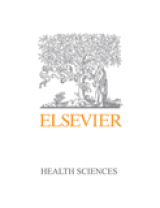This is the seventh edition of a highly regarded, major textbook of paediatrics.
New to this edition
- 51 new chapter authors
- All chapters brought up to date with major re-writes of several chapters
- New chapter on Sleep Problems
- New chapter on Refugee Health
Plus
Free online access to the whole book through www.studentconsult.com, where you will also find:
- Over 500 interactive self-assessment questions
- Further reading
- Links to other helpful online resources
- Additional illustrations
Key Features
- Empahasis on differential diagnosis from a presenting-problem point of view..
- Covers the social and preventative aspects of child health
- Covers the common diseases of childhood and their treatment with a presenting-problem approach
- Contextualises the disease in description of social, genetic and epidemiological factors.
- Clinical example boxes throughout
- Key learning points in Practical Points boxes throughout
- Clearly sign-posted text
Plus
Free online access to the whole book through www.studentconsult.com, where you will also find:
- Nearly 400 interactive self-assessment questions
- Further reading suggetions
- Links to other helpful online resources
- Additional illustrations
Author Information
By Michael South, Specialist in Intensive Care; Director, Department of General Medicine, Royal Children's Hospital; Professor and Deputy Head of Paediatrics, University of Melbourne, Melbourne, Australia and David Isaacs, MB, BChir, MD, MRCP, FRACP, Department of Immunology and Infectious Diseases, The New Children's Hospital, Royal Alexandria Hospital for Children, Australia
Part 1 Current paediatrics.
1.1 Child health and disease
1.2 Child health in a global context
Part 2 Clinical assessment.
2.1 The clinical consultation
2.2 Developmental surveillance and assessment
Part 3 Social and preventative paediatrics.
3.1 The child and the Family
3.2 Indigenous culture and health
3.3 Nutrition
3.4 Obesity
3.5 Immunization
3.6 Trauma
3.7 Failure to thrive
3.8 Developmental disability
3.9 Child abuse
3.10 Sudden unexpected death in infancy
3.11 Care of the adolescent
3.12 Gynaecology
3.13 Sleep problems
3.14 Refugee health
Part 4 Behaviour and mental health needs in childhood.
4.1 Life events of normal children
4.2 Common mental health problems
4.3 Hyperactivity and inattention
4.4 Major psychiatric disorders
Part 5 Paediatric emergencies.
5.1 Emergencies: causes and assessment
5.2 Resuscitation
5.3 Poisoning and envenomation
Part 6 Fluid replacement.
6.1 Fluid replacement therapy
Part 7 Principles of imaging in childhood.
7.1 Imaging
Part 8 Common orthopaedic problems.
8.1 Orthopaedic problems
Part 9 Common paediatric surgical problems.
9.1 Surgical conditions in older children
Part 10 Inherited and metabolic problems.
10.1 Birth defects, prenatal diagnosis and teratogens
10.2 Modern genetics
10.3 The dysmorphic child
10.4 Genetic counselling
10.5 Inborn errors of metabolism
Part 11 Neonatal problems.
11.1 The newborn infant: stabilisation and examination
11.2 Low birth weight, prematurity and jaundice in infancy
11.3 Breathing problems in the newborn
11.4 Congenital and perinatal infections
11.5 Surgical conditions in the newborn
Part 12 Infections
12.1 Infectious disease
12.2 Bone and joint infections
12.3 Meningitis and encephalitis
12.4 Infections in tropical and developing countries
Part 13 Allergy, immunity and inflamation.
13.1 Atopy
13.2 Immunodeficiency and its investigation
13.3 Arthritis and connective tissue disorders
Part 14 Respiratory disorders.
14.1 Acute upper respiratory infections
14.2 Stridor
14.3 Asthma
14.4 Wheezing disorders other than asthma
14.5 Lower respiratory tract infections and abnormalities
14.6 An approach to chronic cough and cystic fibrosis
Part 15 Cardiac disorders.
15.1 Suspected heart disease: assessment
15.2 Heart disease
Part 16 Haematological disorders and malignancies
16.1 Anaemia
16.2 Abnormal bleeding and clotting
16.3 Cancers
Part 17 Seizure disorders and disorders of the nervous system.
17.1 Seizures and epilepsies
17.2 Cerebral palsy and neurodegenerative disorders
17.3 Neuromuscular disorders
17.4 Neural tube defects, large heads and hydrocephalus
17.5 Headaches
Part 18 Urinary tract disorders and hypertension.
18.1 Urinary tract infections and malformations
18.2 Glomerulonephritis, renal failure and hypertension
Part 19 Endocrine disorders.
19.1 Growth and variations of growth
19.2 Thyroid disorders
19.3 The child of uncertain sex
19.4 Diabetes
19.5 Bone mineral disorders
Part 20 Gastrointestinal tract and hepatic disorders.
20.1 Abdominal pain and vomiting
20.2 Infective diarrhoea and inflammatory bowel disease
20.3 Chronic diarrhoea and malabsorption
20.4 Gastro-oesophageal reflux and Helicobacter pylori infection
20.5 Liver diseases
Part 21 Skin disorders.
21.1 Skin disorders
Part 22 ENT, eye and dental disorders.
22.1 Ear, nose and throat disorders
22.2 Eye disorders
22.3 Teeth and oral cavity disorders
Index
From student reviews of the previous edition:
‘This is a very comprehensive paediatrics textbook. It serves well as a general paeds book for your rotation and will sit on your shelf as a reference book past graduation.’
‘This is a really comprehensive book. It has everything you could want to know. It is well written, easy to understand and has lovely illustrations. There are highlighted tables which I liked and the Practical Points boxes are really informative.’
From published reviews of the current edition:
‘A great starter manual as an introduction to paediatrics. The format is user friendly and the practical points and clinical examples help readers solidify their learning.’
Doody Enterprises, Inc.
‘Practical Paediatrics is one of the core paediatric text books for medical students and postgraduate students studying for Diploma of Child Health. …There are Clinical Example boxes scattered within chapters that help keep the information clinically relevant, and the Practical Points boxes neatly summarise the chapter or section information…. There is also a chapter on Indigenous Culture and Health which includes a section on Māori View of Child Health and Illness. One of the best features is the online access which has the full text plus additional features. The additional features include questions in both review format, helpful for revision, and also questions in multi-choice test format with a timer—again a very useful feature for anyone sitting paediatric or child health examinations. There is also a drug database and an image library. This is very good value for money. Overall, this is an excellent textbook that is very relevant to undergraduate and postgraduate students studying paediatrics and child health.’
Maud Meates-Dennis, Senior Lecturer in Paediatrics, University of Otago, Christchurch


